Salmon Flies
|
 |
|
Salmon Fishing |
Trout Fishing |
Sea Trout Fishing |
Fishing
Articles |
Fishing
Maps |
Fly Tying |
Site Contents
Home
Salmon Fishing Scotland
Salmon - Where to Fish
Salmon Fishing Tackle
Salmon Fishing Tactics
Salmon Flies
Trout Fishing Scotland
Trout- Where to Fish
Trout Fishing Tackle
Trout Fishing Tactics
Trout Flies
Sea Trout Fishing Scotland
Sea Trout - Where to Fish
Sea Trout Tackle
Sea Trout Tactics
Sea Trout Flies
Fishing Maps of Scotland
Fishing Articles
Fly Tying
Fishing Photographs
Book of Flies
Fishing Diary
Where to Stay
Fishing Clubs
Fishing Tackle Shops
Fly Fishing Knots
Fishing Weather
Fishing Books
Salmon Recipes
Flies Online
Links
Sitemap
|
Background
to Atlantic Salmon Flies
Although salmon fly fishing was fairly widely practised in
Scotland as early as the eighteenth century, it was not until
the nineteenth century that the
development of the Salmon fly
really took off. The art of the salmon fly dresser reached its
height in the Victorian era, when the earlier rather drab
Scottish fly patterns of William Scrope (e.g. Meg in her Braws,
Kinmont Willie) were supplanted by a flood of highly complex and
exotic creations (Jock Scott, Silver Doctor, Dusty Miller, Mar
Lodge). The popularity of these gaudy patterns continued into
the twentieth century when they were gradually modified,
simplified and supplemented by more sensible salmon flies. First
the low water style of fly dressing was applied to earlier
patterns (Logie, Jeannie, Blue Charm). Then, particularly from
the 1950's, began the development of the modern hairwing salmon
fly (Hairy Mary, Garry, Stoat's Tail, Munro's Killer), which we
know so well today. Recent years have seen wide ranging
developments in salmon fly design, including the slim stainless
needle tubes developed by Grays of Kilsyth.
For photographs of traditional fully dressed Scottish salmon
flies, see
The Salmon Fly
Salmon Fly Development
Recent years have seen the development of many
and varied innovative salmon fly designs. Today's salmon fly
fisherman has a great many weapons in his armoury, ranging from
simple single, double or treble hooks, short or long in the
shank, barbed or barbless; snakes and needle flies; coneheads,
bottle tubes and turbo discs. The tube fly has long been a
favourite of many fly tyers, available in a variety of
materials, such as plastic, aluminium, copper and brass,
allowing flytyers to make tube flies in a useful range of
lengths and weights to suit most river conditions. Another great
advantage of the
tube fly is its durability, as the hook,
whether single, double or treble, can be easily replaced when
damaged. A new range of ultra slim tubes have been developed in
Scotland by Grays of Kilsyth. These very fine, plastic lined,
needle tubes, made from high quality stainless steel tubing, as
used in hypodermic needles, allow the salmon fly tyer to make
extremely slim
salmon tube flies. |
|
|
Salmon Fly Articles
I list below a few articles relating to Salmon
Flies, particularly salmon fly tying and salmon fly fishing,
mainly in Scotland.
|
Scottish Salmon Flies
|
Traditional Scottish Salmon Flies
I list
below just a small selection of some of the most
renowned traditional Scottish salmon flies, spanning
more than a century of Scottish salmon fly
fishing.
Logie
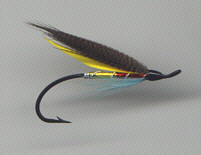 |
One of
our most successful low water patterns, sparsely dressed in the
style of A.H.E.Wood, tenant of Cairnton on the Aberdeenshire Dee
from 1913 to 1934, during which time he killed 3,490 salmon,
most of them on the greased line. The Logie was also a favourite
salmon fly of Frederick Hill who, during the nineteen forties, was gillie
to Captain H.T. Musker at Carlogie, another good low water beat
on the Dee. In "Salmon Fishing", 1948, he wrote, "From the
beginning of April onwards, the Logie is one of our most deadly
flies." The tying shown is the generally accepted dressing and
Hill's preference for early season, fished on a size 4 hook.
Tied on a size 1 hook, it was his favourite for high and
coloured water. |
Jeannie
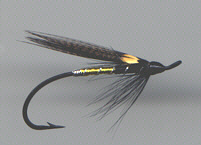 |
The Jeannie is another
low water salmon fly, whose popularity, like that of the Logie,
Blue Charm and Silver Blue, has spread far beyond the Dee, where
it originated. Another of Frederick Hill's favourites for the
early season, again fished on a size 4 hook.
|
Munro's Killer
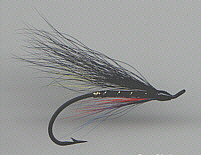 |
Originating on the Spey,
Munro's Killer is a
widely known and enormously successful salmon fly. A modern hairwing
dressing named after J.A.J. Munro, who for many years operated a
fishing tackle shop in Aberlour. |
Jock Scott
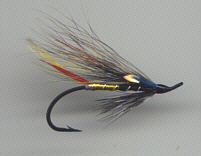 |
The most famous of all
salmon flies, created in 1845 by Jock Scott, (born in 1817 at
Brankholme) who, for twenty five years, served as Fisherman to
Lord John Scott of Kirkbank on Tweed. A successful fly, not
only in Scotland but also in Nova Scotia and New Brunswick in
Canada, in Spain, Iceland, Finland and Norway. Indeed
it was on a voyage to Norway that the first Jock Scott was tied.
Sir Edward Grey, in "Fly Fishing", said of the Jock Scott, "the
best all round fly, excellent for all seasons, weathers and
waters in Great Britain, and to be used of all sizes. I believe
the Jock Scott to be the best blend of colour that has ever been
invented for a salmon fly." High praise indeed. |
Stoat's Tail
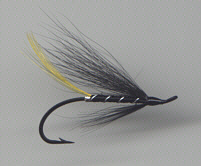 |
In the
words of Hugh Falkus, "Of all hair-wing salmon flies for late
spring and summer fishing with floating line, the simple Stoat's
Tail is one of the best we have." This fly has been around for a
long time and has in all probability accounted for more salmon
than any other fly, particularly if we take into account its
many variants. Some have an orange hackle, as in the Thunder
Stoat and Stinchar Stoat; some a touch of blue, as in the Sweep;
Others sport a tinsel body, as in the Silver Stoat and Black
Brahan. All can be relied on in a wide variety of conditions and
most salmon fly boxes would contain one or two variants,
according to preference and experience. |
Silver Doctor
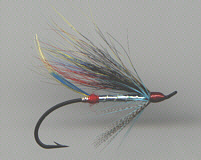 |
The Silver
Doctor is a very attractive
salmon fly,
in common use from the mid nineteenth century on the Tweed
and other border rivers. Attributed to James Wright, of Sprouston, though some believe it may have originated in
Ireland, together with other brightly coloured patterns of
the time. Whatever their origin, the popularity of such
gaudy flies grew and they soon ousted the rather drab
Scottish creations previously in vogue. As a hairwing
pattern it is extremely effective and, a century and a half
after its creation, it retains its well-deserved place in
many a fly box. |
Hairy Mary
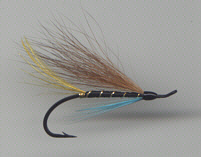 |
The Hairy Mary is one of the earliest hairwing patterns, dating back to around 1950, when it was
in use on northern rivers such as the Ness and Conon. Its
design is attributed to Johnny Reidpath, an Inverness tackle
merchant. In its simplicity, this fly is in marked contrast to the
highly complex creations of the previous century, yet no
less effective in luring salmon.
|
Garry
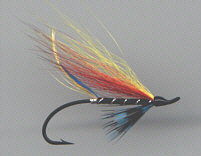 |
Known
also as the Garry Dog, Yellow Dog or Minister's Dog, the name
originated in a Tweed tackle shop of the 1920's, where a
visiting minister contributed some hair from the tail of his
dog, a golden retriever named Garry, to aid the completion of a
fly under construction on the premises. While yellow bucktail or
similar hair is now substituted for the dog's hair, the Garry
remains an excellent salmon fly pattern for coloured water, particularly in
the autumn. see also
Salmon Flies |
|
|
|
privacy |
|
|
|
Trout and Salmon Fishing |
|